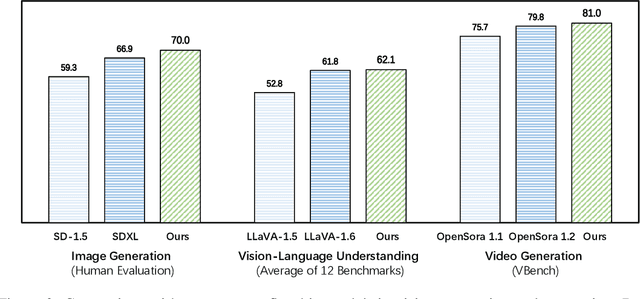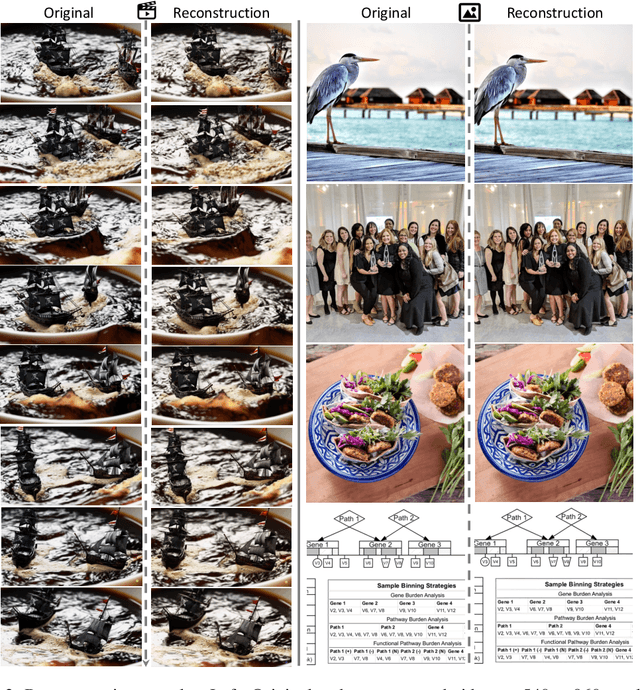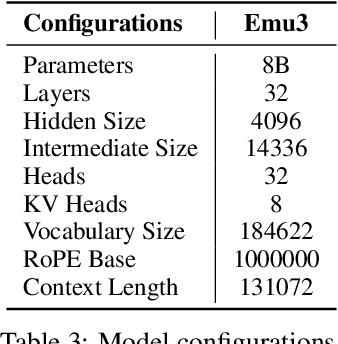Zheqi He
Emu3: Next-Token Prediction is All You Need
Sep 27, 2024



Abstract:While next-token prediction is considered a promising path towards artificial general intelligence, it has struggled to excel in multimodal tasks, which are still dominated by diffusion models (e.g., Stable Diffusion) and compositional approaches (e.g., CLIP combined with LLMs). In this paper, we introduce Emu3, a new suite of state-of-the-art multimodal models trained solely with next-token prediction. By tokenizing images, text, and videos into a discrete space, we train a single transformer from scratch on a mixture of multimodal sequences. Emu3 outperforms several well-established task-specific models in both generation and perception tasks, surpassing flagship models such as SDXL and LLaVA-1.6, while eliminating the need for diffusion or compositional architectures. Emu3 is also capable of generating high-fidelity video via predicting the next token in a video sequence. We simplify complex multimodal model designs by converging on a singular focus: tokens, unlocking great potential for scaling both during training and inference. Our results demonstrate that next-token prediction is a promising path towards building general multimodal intelligence beyond language. We open-source key techniques and models to support further research in this direction.
Evaluating Attribute Comprehension in Large Vision-Language Models
Aug 25, 2024



Abstract:Currently, large vision-language models have gained promising progress on many downstream tasks. However, they still suffer many challenges in fine-grained visual understanding tasks, such as object attribute comprehension. Besides, there have been growing efforts on the evaluations of large vision-language models, but lack of in-depth study of attribute comprehension and the visual language fine-tuning process. In this paper, we propose to evaluate the attribute comprehension ability of large vision-language models from two perspectives: attribute recognition and attribute hierarchy understanding. We evaluate three vision-language interactions, including visual question answering, image-text matching, and image-text cosine similarity. Furthermore, we explore the factors affecting attribute comprehension during fine-tuning. Through a series of quantitative and qualitative experiments, we introduce three main findings: (1) Large vision-language models possess good attribute recognition ability, but their hierarchical understanding ability is relatively limited. (2) Compared to ITC, ITM exhibits superior capability in capturing finer details, making it more suitable for attribute understanding tasks. (3) The attribute information in the captions used for fine-tuning plays a crucial role in attribute understanding. We hope this work can help guide future progress in fine-grained visual understanding of large vision-language models.
CMMU: A Benchmark for Chinese Multi-modal Multi-type Question Understanding and Reasoning
Jan 26, 2024



Abstract:Multi-modal large language models(MLLMs) have achieved remarkable progress and demonstrated powerful knowledge comprehension and reasoning abilities. However, the mastery of domain-specific knowledge, which is essential for evaluating the intelligence of MLLMs, continues to be a challenge. Current multi-modal benchmarks for domain-specific knowledge concentrate on multiple-choice questions and are predominantly available in English, which imposes limitations on the comprehensiveness of the evaluation. To this end, we introduce CMMU, a novel benchmark for multi-modal and multi-type question understanding and reasoning in Chinese. CMMU consists of 3,603 questions in 7 subjects, covering knowledge from primary to high school. The questions can be categorized into 3 types: multiple-choice, multiple-response, and fill-in-the-blank, bringing greater challenges to MLLMs. In addition, we propose a rigorous evaluation strategy called ShiftCheck for assessing multiple-choice questions. The strategy aims to reduce position bias, minimize the influence of randomness on correctness, and perform a quantitative analysis of position bias. We evaluate seven open-source MLLMs along with GPT4-V, Gemini-Pro, and Qwen-VL-Plus. The results demonstrate that CMMU poses a significant challenge to the recent MLLMs.
 Add to Chrome
Add to Chrome Add to Firefox
Add to Firefox Add to Edge
Add to Edge